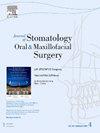口腔鳞状细胞癌(OSCC)CN0隐匿性颈淋巴结转移的发生率。
IF 1.8
3区 医学
Q2 DENTISTRY, ORAL SURGERY & MEDICINE
Journal of Stomatology Oral and Maxillofacial Surgery
Pub Date : 2024-09-08
DOI:10.1016/j.jormas.2024.102070
引用次数: 0
摘要
隐匿性转移不易通过临床或影像学检查发现。对于临床上的 N0,有多种方法可用于颈部控制,如选择性颈部清扫术(END)、等待和观察(W&W)以及前哨淋巴结活检(SLNB)。本研究的主要目的是调查口腔鳞状细胞癌cN0中隐匿性颈淋巴结转移的发生率,并调查和比较隐匿性转移组和非隐匿性组在马来亚大学牙科学院口腔颌面外科诊所就诊时的无病状态和总生存率。这是一项回顾性研究,涉及48名患者,数据完整,时间跨度为2008年至2019年。收集的数据包括社会人口学和临床病理学因素。研究人员进行了描述性分析,并使用卡普兰-梅尔分析法比较隐匿转移组和非隐匿转移组的无病状态和总生存期。在口腔鳞状细胞癌(OSCC)中,隐匿性转移的发生率较低,仅为8.3%,但在OSCC舌癌中,隐匿性转移的发生率达到了100%。隐匿性转移的主要肿瘤部位来自口腔舌部,肿瘤大小为T2。与隐匿转移组和晚期组相比,非隐匿组的总生存率更高。因此,建议对N0 OSCC舌进行END治疗。本文章由计算机程序翻译,如有差异,请以英文原文为准。
Prevalence of occult cervical lymph nodes metastasis in CN0 in oral squamous cell carcinoma (OSCC)
Occult metastasis is not easily detected clinically or radiographically. Various methods have been applied for neck control for clinically N0 via elective neck dissection (END), wait and watch (W&W) and sentinel lymph node biopsy (SLNB). The main aim of this study is to investigate the prevalence of occult cervical lymph nodes metastasis in cN0 in oral squamous cell carcinoma, to investigate and compare the disease-free state and overall survival rate between occult metastasis and the non-occult group that presented at the oral and maxillofacial surgery clinic, Faculty of Dentistry, Universiti Malaya. This is a retrospective study involving 48 patients with complete data from 2008 to 2019. Data collected includes socio-demographic and clinicopathologic factors. Descriptive analysis was performed and Kaplan-Meier analysis was used to compare disease-free status and overall survival period between occult and non-occult metastases groups. The prevalence of occult metastasis in oral squamous cell carcinoma (OSCC) was low at 8.3 % but it became 100 % on OSCC tongue. The main tumor site for occult metastasis originated from the oral tongue with T2 size. Non-occult group had better overall survival rate comparing to occult metastasis group and the advanced group. Therefore, END is recommended particularly for N0 OSCC tongue.
求助全文
通过发布文献求助,成功后即可免费获取论文全文。
去求助
来源期刊

Journal of Stomatology Oral and Maxillofacial Surgery
Surgery, Dentistry, Oral Surgery and Medicine, Otorhinolaryngology and Facial Plastic Surgery
CiteScore
2.30
自引率
9.10%
发文量
0
审稿时长
23 days
 求助内容:
求助内容: 应助结果提醒方式:
应助结果提醒方式:


